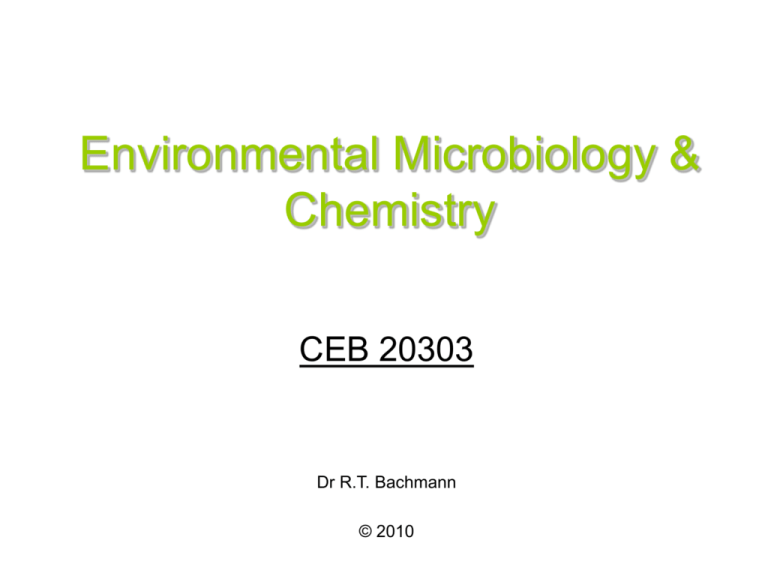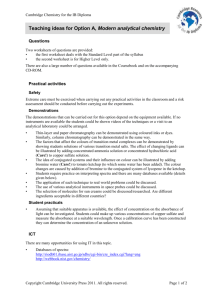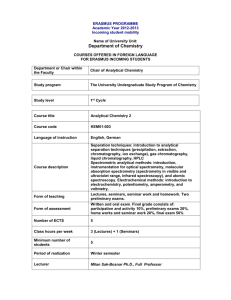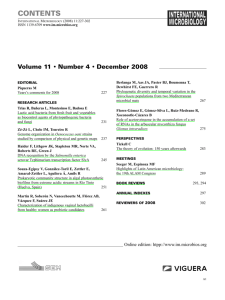
Environmental Microbiology &
Chemistry
CEB 20303
Dr R.T. Bachmann
© 2010
Assessment Methods
• 40 % exam and 60 % course works (3 lab
reports, 1 assignment, 1 test).
• Scheduled duration of exam: 3 hr
• Lab reports will be assessed based on
following 2 sets of criteria:
– Layout (Frontpage, clear logical structure of
report, labelling of figures, tables, pages) –
ca. 30 %
– Report quality (Introduction, M&M, Results,
Task answers, Discussion, Conclusions,
References) – ca. 70 %
Teaching Schedule & Methods
• 14 x 2 hr lectures (Tue, 3-5 PM, BK2);
• Laboratory (6 groups á 3 students)
A
B
C
D
E
F
G
Teaching Schedule & Methods
• Laboratory time table
No.
MONDAY
(10-1PM)
Title
FRIDAY
(3-6PM)
1
Acid-base reaction (neutralisation of H2SO4) and concurrent
Cr(III) precipitation using NaOH and KOH
A-C
D-F
2
Reaction kinetics of electrolytic Cr(VI) reduction in aqueous
acidified solution.
A-C
D-F
3
Microbial growth and growth monitoring methods
A-C
D-F
Public holidays
15-16th February
: Chinese New Year & Mid-sem break
26th February (Fri) : Prophet Muhammad’s Birthday (Maulidur Rasul)
15th April (Mon)
: Declaration of Melaka as a Historical City
Assignment
Report
Deadline
: Individual
: 9th April 2010
Outline:
•
Find a journal paper investigating the treatment of polluted air, water, soil or waste (or
renewable energy) based on a bio-chemical process;
•
Briefly describe using your own words & references (!!) the process principle, chemical
reactions (type of reaction, kinetics), function of microorganisms in the process and biotic /
abiotic factors that affect these organisms as well as analytical methods used;
•
List advantages and disadvantages of the biochemical process and compare with other
treatment options;
The report will be marked based on
i) report layout (clear and logical structure, informative frontpage, table of content, list of figures /
tables, references, labeling of tables, figures and pages),
[30 %]
ii) report quality (concise, relevant and well referenced answers to each task)
[65 %]
And
iii) on-time submission of report (bonus point for on-time submission).
[5 %]
Policies
• Professional behavior expected
– punctual
– courteous, respectful and non-distractive
– TURN CELL PHONES OFF IN CLASS!
• Academic dishonesty
– representing the work of others as your own will result
in a grade of 0.0 for the course. In most cases, formal
disciplinary action will also be initiated
References
Text Books
•
•
•
•
•
•
•
•
•
•
•
Sawyer C.N. & McCarty PL. (2002) Chemistry for Environmental Engineers. 5th edition,
McGraw Hill, ISBN-13: 978-0072480665.
Stumm, W. & Morgan, J.J. (1996) Aquatic Chemistry. 3rd Ed., Wiley-Interscience, ISBN-13:
978-0471511854.
Birkett, J. (1999) Microbiology and Chemistry for Environmental Scientists and Engineers. 1st
Ed., Taylor & Francis; ISBN-13: 978-0419226802.
Madigan, M.T., Martinko, J.M. (2006) Brock Biology of Microorganisms. Pearson Prentice Hall,
11th ed., ISBN-13: 9780131968936.
Pelczar, M.J., Chan, E.C.S., & Krieg, N.R. (1986) Microbiology. 5th Ed., McGraw-Hill, ISBN-13:
978-0070492349.
Cappuccino, J.G. & Sherman, N. (1999) Microbiology : a laboratory manual. 8th Ed., Benjamin
Cummings, ISBN-13: 978-0805325782.
Mitchell, R. (1993) Environmental Microbiology. Wiley-Liss, ISBN-13: 978-0471595878.
Maier, R.M., Pepper, I.L., Gerba, C.P. (2000) Environmental Microbiology. Academic Press, 1st
ed., ISBN-13: 978-0124975705.
Jjemba, P.K. (2004) Environmental Microbiology: Principles and Applications. Science
Publishers, ISBN-13: 978-1578083480.
Gerhardt, P., Murray, R.G.E., Wood, W.A. & Krieg, N.R. (1994) Methods of general and
molecular bacteriology. American Society for Microbiology, Washington, USA, ISBN:
1555810489
APHA Standard method for examination of water and wastewater analysis. 20th Ed.
References
Online references
•
Microscopy:
http://www.epa.gov/ogwdw000/lt2/training/module_basicmicroscopy/scopage_dir/ba
sic/basic.html
http://micro.magnet.fsu.edu/primer/java/dic/dicphaseos/index.html
http://www.invitrogen.com/site/us/en/home/References/Molecular-Probes-TheHandbook.html
1.0 Introduction
Environment?
Microbiology?
Chemistry?
Environment
Microbiology
Chemistry
Are these subjects linked
at all?
Let’s take one step at a time & ask
ourselves what comes to our mind
when we talk about
Environment, Microbiology &
Chemistry?
Chemistry
Microbiology
Metabolism
Physiology
Atmosphere
Inorganic
Precipitation
O2
Abiotic
H2O
NO3
Radiation
Parasitism
Natural
Chromatography
Biochemical
Inorganic
Man-made
C-H-O-N-P-S-metal cycles
Molar
Mass
Chemical
reactions
Chemical
equations
Phospholipids
temperature
Redox
Physico-chemical
Biogeochemical
Biodegradation
Mutualism
Mole
Stoichiometry
Pollution
SO4
Phylochip
Fe(III)
ATP
Gas
Chromatography
Genetic
Hydro~
Atomic Absorption
Spectroscopy
Spectroscopy
Biosphere
Most probable
number (MPN)
X-Ray
Polymerase Chain Reaction (PCR)
Spectrophotometry
Litho
~
Competitor
Plate count
Predator
Biochemical
Biotic
Gas
Commensalism
Mass
Spectroscopy
Electron acceptors
Growth
conditions
pressure
pH
Ecology
Detection
Energy
source
Organic
Environment
Acid-base
Symbiosis
Analytical methods
Carbon
source
Radiation
Weathering
Voltammetry
HPLC
As you can see it’s quite a lot!!
How can we make sense of all
these topics and illustrate their
relationships??
Mind maps may be the solution…
Example of a mind map to increase understanding and perspectives by asking questions.
What is Happiness? A personal exploration of the subject by Paul Foreman
Principles of Mind Maps
An overview of the key "laws" of Mind Mapping, all of which aim to maximise the usefulness of the
technique.
Example of a mind map to increase understanding and perspectives by asking questions.
Let’s play a GAME and prepare to
built our own mind-map!
1.
How does it work?
Form 5 teams A to E (draw cards provided);
Rules:
Teams take turn to pick keyword and assign to
correct category (Environment, Microbiology,
Chemistry).
Individual team member must take turns to select
and assign correct category.
For each correct assignment team will receive one
point.
If team cannot answer correctly within 90 sec other
teams have chance to answer and earn the point.
Team with maximum points will be CHAMPION.
Chemistry
Microbiology
Metabolism
Physiology
Atmosphere
Inorganic
Ecology
Commensalism
NO3
Polymerase Chain Reaction (PCR)
O2
Abiotic
H2O
Gas
ATP
Natural
Atomic Absorption
Spectroscopy
Parasitism
Spectroscopy
Molar
Mass
Mutualism
Mole
Chromatography
Gas
Chromatography
Chemical
reactions
Chemical
equations
Phospholipids
temperature
Symbiosis
Pollution
Biochemical
Inorganic
Man-made
C-H-O-N-P-S-metal cycles
Acid-base
Redox
Physico-chemical
Biogeochemical
Biodegradation
SO4
Phylochip
Fe(III)
Stoichiometry
Biosphere
Litho
~
Radiation
Genetic
Hydro~
Spectrophotometry
Precipitation
Most probable
number (MPN)
X-Ray
Biochemical
Biotic
Plate count
Predator
Mass
Spectroscopy
Electron acceptors
Growth
conditions
pressure
pH
Competitor
Detection
Energy
source
Organic
Environment
Analytical methods
Carbon
source
Radiation
Weathering
Voltammetry
HPLC
Q1: Which of the following “sphere” statements is correct?
A - Biosphere is part of the atmosphere.
B – Atmosphere, biosphere and hydrosphere are
part of the lithosphere
C – Biosphere is part of the environment and
comprises of atmosphere, hydrosphere and
lithosphere.
D – All of the above.
Q2: TRUE or FALSE?
A – Physico-chemical weathering of
rocks / minerals is caused by microorganisms and their metabolic byproducts.
B – Physico-chemical weathering of
rocks / minerals is caused by i) water
undergoing repeated cycles of freezing &
thawing, ii) extreme temperature
fluctuations between day and night time,
and iii) acid rain dissolving minerals.
C – Biochemical processes in the
environment involve the breakdown of
organic and inorganic compounds
through microbial action.
Q3: How can we best describe abiotic factors?
A) The non-living components of the environment,
such as air, rocks, soil, water, peat, and plant litter.
B) Non-living chemical and physical factors in the
environment such as radiation, temperature, pH,
pressure and water.
C) Abiotic factors are part of a special category of
food additives designed to improve the nutritional
value of food.
D) It is a mathematical term referring to algebra of
bounded operators on a Hilbert space that is closed
in the weak non-living operator.
Q4: Stoichiometry in chemistry is defined as the relation
between the quantities of substances that take part in
a reaction. Which of the following stoichiometric
equations are correct?
A) CH4 (g) + O2 (g) → 2CO2 (g) + H2O (g)
B) 2O2 (g) + CH4 (g) → CO2 (g) + 2H2O (g)
C) 2KOH (aq) + Fe(NO3)3 (aq) → Fe(OH)3 (s) + 2KNO3 (aq)
D) NaOH + H2SO4 → Na2SO4 + 2H2O (aq).
Q5: What is the correct definition and unit for molarity?
A) Mass of solute per number of moles
of solution (e.g. mg/mol).
B) Number of moles of solute per mass
of solvent (e.g. mol / kg).
C) Number of moles of solute per
volume of solution (e.g. kmol dm-3).
D) None of the above.
Correct Answers!
1c
2 a : False
2 b : Correct
2 c : Correct
3b
4b
5c
S
1 Mark
1 Mark
1 Mark
1 Mark
1 Mark
1 Mark
1 Mark
7 Marks
Let’s built our own mind-map!
1. Write the title in centre of piece of paper.
Try and use keywords if possible.
2. As a first level branch create a “Chemistry”
branch. Then under this create following subbranches: Kinetics, Equilibrium, Analytic,
Reactions, Stoichiometry
3. For the rest of your mind map add 1st level
branches for each of the main topics of this
subjects.
Chemistry
Microbiology
Metabolism
Physiology
Atmosphere
Inorganic
Ecology
Commensalism
NO3
Polymerase Chain Reaction (PCR)
O2
Abiotic
H2O
Gas
ATP
Natural
Atomic Absorption
Spectroscopy
Parasitism
Spectroscopy
Molar
Mass
Mutualism
Mole
Chromatography
Gas
Chromatography
Chemical
reactions
Chemical
equations
Phospholipids
temperature
Symbiosis
Pollution
Biochemical
Inorganic
Man-made
C-H-O-N-P-S-metal cycles
Acid-base
Redox
Physico-chemical
Biogeochemical
Biodegradation
SO4
Phylochip
Fe(III)
Stoichiometry
Biosphere
Litho
~
Radiation
Genetic
Hydro~
Spectrophotometry
Precipitation
Most probable
number (MPN)
X-Ray
Biochemical
Biotic
Plate count
Predator
Mass
Spectroscopy
Electron acceptors
Growth
conditions
pressure
pH
Competitor
Detection
Energy
source
Organic
Environment
Analytical methods
Carbon
source
Radiation
Weathering
Voltammetry
HPLC
Inorganic
O2
Carbon
source
Fe(III)
NO3
Commensalism
SO4
Parasitism
Predator
Electron acceptors
Symbiosis
Metabolism
Organic
Competitor
Energy
source
Inorganic
Mutualism
Plate count
MPN
Radiation
PCR
Growth
conditions
Radiation
T
Abiotic
Factors
Biochemical
Epifluorescence
ATP
HA H+ + A-
Biotic
Factors
H2O
Hydro~
Biosphere
Mole
Man-made
Molar
Mass
Chemical
equations
Stoichiometry
ENVIRONMENT
CHEMISTRY
Zero
Litho~
Natural
Phospholipids
Acid Base
Gas
Atmo~
Phylochip
Light ~
p
pH
Genetic
Microscope
Pollution
Processes
Kinetics
Chemical
Equilibrium
Order
First
Acid-base
Chemical
reactions
Precipitation
Spectrophoto
metry
Second
Biogeochemical
Physicochemical
Biochemical
AAS
MS
Spectroscopy
XRay
C-H-O-N-P-S-metal cycles
Biodegradation
Weathering
Analytical
Chromatography
GC
Redox
Voltammetry
HPLC
Experiment 1:
“Chemical Redox Reaction”
TASKS
(refer to electronic handout)
1. Read the provided CoSHH / RA forms carefully and sign if you understand and agree with
the content.
2. Prepare a 100 g aqueous solution containing 100 mg Cr(VI) / kg and 10 % w/w H2SO4.
3. In increments, add premeasured amount of 1 M FeSO4 (or 1 M Na2SO3), whatever
provided by personnel) to 100 g aqueous acidified solution (task 2) and monitor Cr(VI)
concentration based on the 1,5 diphenylcarbohydrazide method. Notice any change in
colour and appearance.
4. Define mol, molarity and molality.
5. Calculate the molarity and molality of Cr in the aqueous solution (from task 2).
6. Define ‘redox-reaction’ and determine which reactant (Cr(VI), FeSO4) is the oxidizing and
reducing agent.
7. Establish the stoichiometric equation for the redox reaction based on the half-reaction
method.
8. Plot the normalized Cr(VI) concentration (Ccr[vi] / Ccr[initial]) vs. molar ratio X (nFe / nCr[VI]) and
apply suitable trendline (linear, polynomial, exponential).
9. Compare theoretical stoichiometric equation (task 7) with experimental values. Discuss
potential causes if discrepancies between theoretical and experimental values are observed
(>10 % difference).
10. Describe the principle of the 1,5 diphenylcarbohydrazide method and identify to which
category of analytical method it belongs to.
Submit your lab report in 2 weeks time (counting starts from day of lab experiment).
LAB RULES
1. LABORATORY SAFETY REGULATION
2. CHEMICAL HANDLING
3. PERSONAL SAFETY & PERSONAL RESPONSIBILITY
4. HOUSEKEEPING
5. WASTE DISPOSAL
6. PERSONAL PROTECTION EQUIPMENT
7. LABORATORY SAFETY EQUIPMENT
8. LABORATORY’S EQUIPMENT SAFETY
9. FIRST AID AND EMERGENCY PROCEDURES
10. FIRE ACTION PLAN
LAB INDUCTION SEMINAR
When?
Where?
: Tuesday, 1-2PM
: DK1







